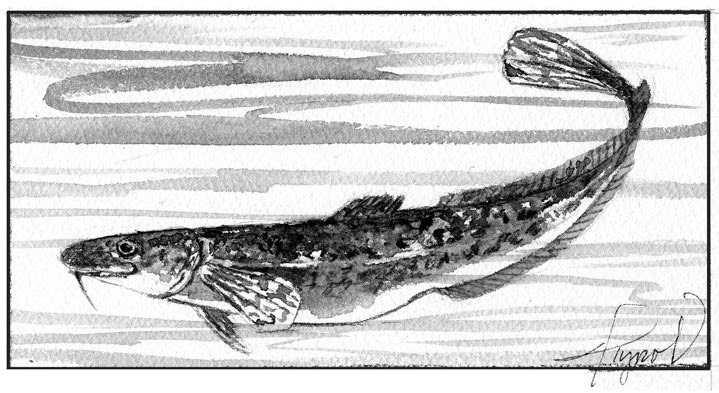
I can’t say for sure exactly how many of my childhood birthdays were celebrated on the ice of Lake Champlain, but a good number. That’s what happens when your father likes to ice fish, and your big day happens to fall on Dead President’s week, when every school in the state goes on vacation.
But I am reasonably certain it was on my twelfth birthday when I first met Lota lota, a fish my dad called a “ling” and others call “burbot,” “cusk” or “eelpout.” We were jigging for yellow perch on a shallow hump on the outskirts of St. Albans Bay when I pulled one through the ice. I remember thinking I’d caught a chunky American eel, but my dad quickly set the record straight by dislodging the 16-inch fish from my hook and quickly tossing it into the 5-gallon pail we were using to collect perch for a fish fry.
“Those,” I remember my father saying, “are excellent eating.”
Indeed they are. Burbot are the only freshwater members of the cod family, and their white, flakey flesh is surprisingly similar to that of their ocean-faring cousins.
Burbot are found in coldwater lakes and rivers throughout much of New England. They’re common, but because they feed primarily at night and inhabit deep water, many anglers will go a whole lifetime without seeing one.
“Burbot are found in our deeper lakes, particularly in the Northeast Kingdom,” said Bernie Pientka, a fisheries biologist with the Vermont Fish and Wildlife Department. “Beyond Lake Champlain, places like Lake Willoughby and Lake Memphremagog hold good populations of them.”
In New Hampshire, burbot are found in water bodies from the Connecticut Lakes to Lake Winnipesaukee and the Squam lakes.
Burbot are long and thin, which explains how a teenager might mistake one for an eel. They’re essentially a streamlined version of a cod, sort of in the shape of a bowfin. They are dark brown – a mottled tan really – and like a cod, have a barbel that hangs off the chin. Burbotskin is especially slimy; this mucoprotein, as scientists call it, is a protective coating against parasites and disease.
An average specimen is around 20 inches in length. The Vermont state record was caught in 2012 in Lake Champlain and weighed 8 pounds, 13 ounces. Winnipesaukee coughed up the Granite State record – a 12-pounder that measured out at 34½ inches. Their nocturnal habits and slow movements are not very attractive to sport fishermen, but there’s a long history of commercial fishing for burbot in the Great Lakes. In Europe, burbot liver, which is enormous and exceedingly high in vitamins A and D, is sold smoked and canned.
The burbot’s dark, drab color helps it blend in on the bottom of a lake, where they spend most of their lives. In summer, burbot are often found in the deepest parts of a lake, sometimes as far down as 300 or 400 feet.
“They tend to relate to deep water structure,” said Pientka. “They’ll be in crevices and depressions. They’ll eat fish, fish eggs, and crustaceans, and will scavenge, eating dead fish.
Spawning season, which is taking place now, is one of the few times burbot are found in shallower water. They’ll move from the deeps to spawn on gravelly or sandy shoals, often in water less than 10 feet deep. One lyrical fisheries biologist from Minnesota described spawning burbot as a “living glob.” Apparently, as many as 100 fish might get together, where they’ll “form a quivering sphere of tangled bodies and release eggs and milt into the turbulent water.”
However, because burbot usually inhabit deep, cold water, anglers who specifically target them use creative equipment to reach the depths they inhabit. In New Hampshire, for instance, fishing regulations on a handful of lakes allow for the use of a special cusk line – a singlehook, line, and sinker that sits on the bottom of the lake unattended; typically a fisherman sets the line in the evening and checks it in the morning.
I was using a simple perch jig, probably using a fish eye for bait, when I caught my first burbot/ling/cusk. And while I’ve only caught a handful since that day, I’ve grown to develop an appreciation for them, both as denizens of the deep, and simmered in a little olive oil, white wine, and cracked pepper.


Discussion *